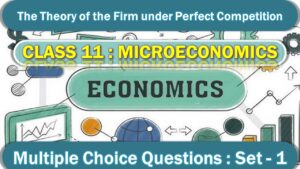CBSE Class 12 Current Electricity Multiple Choice Questions with Answers. MCQ Questions Class 12 Current Electricity with Answers Is Prepared Based on Latest Exam Pattern. Students can solve NCERT Class 12 Current Electricity MCQs with Answers to know their preparation level.
Students who are searching for NCERT MCQ Questions for Class 12 Current Electricity with Answers are compiled here to get good practice on all fundamentals. Know your preparation level on MCQ Questions for Class 12 Current Electricity with Answers. You can also verify your answers from our provided MCQ Class 12 Current Electricity with Answers. So, ace up your preparation with MCQ of Class 12 Physics Examinations.
MCQ Questions Class 12 Current Electricity with Answers - Set - 2
Question 1:
If a certain piece of copper is to be shaped into a conductor of minimum resistance, its length (L) and cross-sectional area (a) shall respectively be :
(a) L, 2A
(b) 2A, L/2
(c) 2L, 2A
(d) 2l, A/2
Correct Answer – (A)
Question 2 :
Specific resistance of ali metals is mostly affected by:
(a) temperature
(b) pressure
(c) magnetic field
(d) volume
Correct Answer – (A)
Question 3 :
How many different resistances are possible with two equal resistors?
(a) 2
(b) 3
(c) 4
(d) 5
Correct Answer – (B)
Question 4 :
The resistance of a human body is about:
(a) 12 Ω
(b) 120 Ω
(c) 12 KΩ
(d) 120 MΩ
Correct Answer – (C)
Question 5 :
In an experiment to measure the internal resistance of a cell by a potentiometer, it is found that the balance point is at a length of 2 m, when the cell is shunted by a 5Ω resistance and is at 3 m when the cell is shunted by a 10Ω resistance. The internal resistance of the cell is:
(a) 10 Ω
(b) 15 Ω
(c) 1 Ω
(d) 1.5 Ω
Correct Answer – (A)
MCQ Questions Class 12 Current Electricity with Answers
Question 6 :
The example of a non-ohmic resistance is:
(a) copper wire
(b) fi lament lamp
(c) carbon resistor
(d) diode
Correct Answer – (D)
Question 7 :
Given three equal resistors, how many different combinations (taken all of them together) can be made?
(a) 3
(b) 4
(c) 5
(d) 6
Correct Answer – (B)
Question 8 :
The number of electrons that constitute 1 A of current is:
(a) 6.25 × 1016
(b) 6.25 × 1017
(c) 6.25 × 1018
(d) 6.25 × 1019
Correct Answer – (C)
Question 9 :
The speed at which tjie current travels in a conductor is nearly:
(a) 3 × 104 ms-1
(b) 3 × 106 ms-1
(c) 3 × 108 ms-1
(d) 3 × 1010 ms-1
Correct Answer – (A)
Question 10 :
The effective wattage of 60 W and 40 W lamps connected in: (A) series is equal to:
(a) 24 W
(b) 20 W
(c) 100 W
(d) 80 W.
Correct Answer – (A)
- NCERT Solutions Class 11 Chemistry Chapter 1 : Some Basic Concepts of Chemistry
- NCERT Solutions Class 11 Chemistry Chapter 2 : Structure Of The Atom
- NCERT Solutions Class 11 Chemistry Chapter 3 : Classification of Elements and Periodicity in Properties
- NCERT Solutions Class 11 Chemistry Chapter 4 : Chemical Bonding and Molecular Structure
- NCERT Solutions Class 11 Chemistry Chapter 5 : States of Matter
- NCERT Solutions Class 11 Chemistry Chapter 6 : Thermodynamics
- NCERT Solutions Class 11 Chemistry Chapter 7 : Equilibrium
- NCERT Solutions Class 11 Chemistry Chapter 8 : Redox Reactions
- NCERT Solutions Class 11 Chemistry Chapter 9 : Hydrogen
- NCERT Solutions Class 11 Chemistry Chapter 10 : The s-Block Elements
- NCERT Solutions Class 11 Chemistry Chapter 11 : The p-Block Elements
- NCERT Solutions Class 11 Chemistry Chapter 12 : Organic Chemistry: Some Basic Principles and Techniques
- NCERT Solutions Class 11 Chemistry Chapter 13 : Hydrocarbons
- NCERT Solutions Class 11 Chemistry Chapter 14 : Environmental Chemistry




